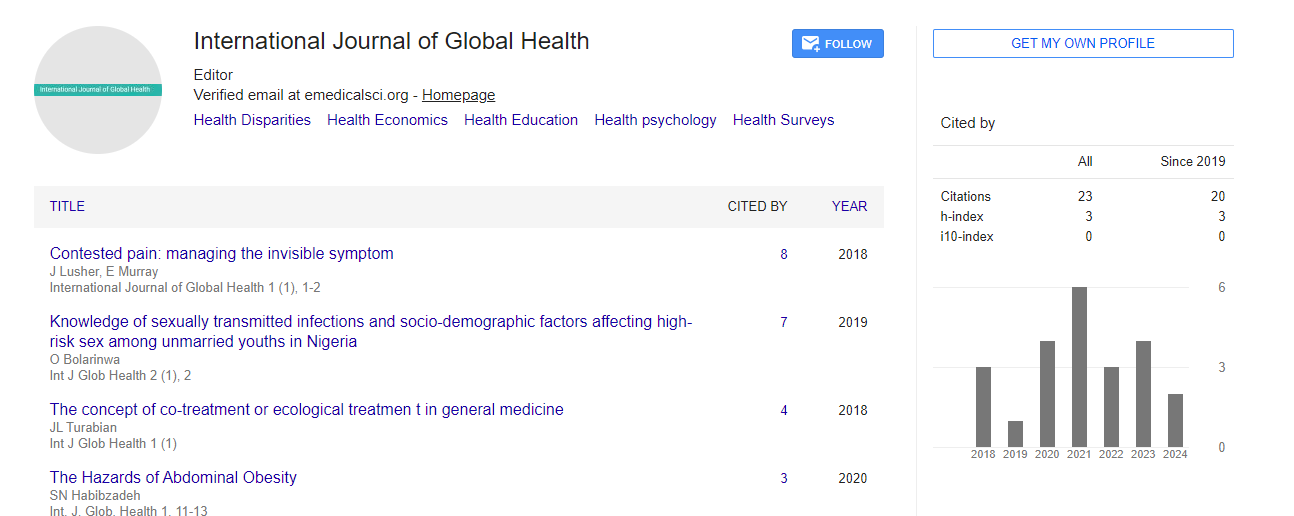Perspective, Int J Glob Health Vol: 6 Issue: 3
Biostatistical Considerations in Health Policy Evaluation
Johan Persson*
1Department for Epidemiology and Biostatistics, National Institute for Health Development, Tallinn, Estonia
*Corresponding Author: Johan Persson,
Department for Epidemiology and
Biostatistics, National Institute for Health Development, Tallinn, Estonia
E-mail: johan.persson@nihd.ee
Received date: 28 August, 2023, Manuscript No. IJGH-23-116157;
Editor assigned date: 30 August, 2023, PreQC No. IJGH-23-116157 (PQ);
Reviewed date: 13 September, 2023, QC No. IJGH-23-116157;
Revised date: 21 September, 2023, Manuscript No. IJGH-23-116157 (R);
Published date: 29 September, 2023, DOI: 10.4172/Ijgh.1000189
Citation: Persson J (2023) Biostatistical Considerations in Health Policy Evaluation. Int J Glob Health 6:3.
Description
Health policy evaluation is an important component of healthcare systems, helping policymakers assess the impact of policies and interventions on public health outcomes, resource allocation, and overall healthcare quality. Biostatistics, as a multidisciplinary field combining biology and statistics, plays a pivotal role in the rigorous evaluation of health policies.
Study design
Randomized Controlled Trials (RCTs): RCTs are considered the gold standard for evaluating health policies. Biostatisticians design RCTs to randomly assign individuals or communities to intervention and control groups. This ensures that any observed differences in outcomes can be attributed to the policy under evaluation.
Observational studies: In cases where RCTs are not feasible or ethical, biostatisticians design observational studies, such as cohort studies or case-control studies. These studies require careful selection of study populations and appropriate statistical methods to control for confounding variables.
Outcome measurement
Primary and secondary outcomes: Biostatisticians work with policymakers to define primary and secondary outcomes that are relevant to the policy's objectives. These outcomes should be measurable, clinically meaningful, and sensitive to the policy's effects.
Surrogate endpoints: In some cases, surrogate endpoints are used to assess the effectiveness of a policy. Biostatisticians must validate the relationship between surrogate endpoints and clinical outcomes to ensure accurate evaluation.
Sample size and power calculation
Biostatisticians determine the required sample size to detect a meaningful effect size with sufficient statistical power. Inadequate sample sizes can lead to underpowered studies that fail to detect true policy effects.
Data collection and management
Biostatisticians oversee data collection, ensuring the use of standardized and validated measurement tools. They also establish data quality control procedures to minimize errors and missing data.
Electronic Health Records (EHRs) and healthcare databases are valuable sources of data for policy evaluation. Biostatisticians develop strategies to harness these resources effectively.
Statistical analysis
Causal inference: Evaluating health policies often requires establishing causality. Biostatisticians employ various methods, including propensity score matching and instrumental variable analysis, to address confounding variables and estimate causal effects.
Time-series analysis: For policies with temporal effects, biostatisticians use time-series analysis to assess trends before and after policy implementation. Interrupted time series designs are commonly used.
Survival analysis: In cases where policy evaluation involves timeto- event data, survival analysis techniques, such as Kaplan-Meier curves and Cox proportional hazards models, are employed.
Cost-effectiveness analysis: Biostatisticians conduct costeffectiveness analyses to assess the economic impact of health policies. These analyses require modeling and sensitivity analysis to account for uncertainties.
Randomization and blinding
In RCTs, randomization is used to allocate participants to intervention groups, ensuring comparability. Biostatisticians design randomization procedures and oversee their implementation.
Blinding, both single-blind and double-blind, is employed to minimize bias in RCTs. Biostatisticians assess the feasibility and effectiveness of blinding strategies.
Ethical considerations
Biostatisticians work closely with ethics committees to ensure that health policy evaluations adhere to ethical principles, including informed consent and protection of participants' rights.
Reporting and communication
Biostatisticians play a vital role in data interpretation and communication. They collaborate with policymakers to present findings accurately and clearly to diverse audiences.
Peer review and reproducibility
Rigorous peer review of health policy evaluations is essential to ensure the validity and reliability of results. Biostatisticians contribute to transparent reporting and the sharing of data and analysis code to promote reproducibility.
Conclusion
Biostatistical considerations are integral to the design, execution, and interpretation of health policy evaluations. These considerations help policymakers make evidence-based decisions, improve healthcare systems, and enhance public health outcomes. By applying rigorous biostatistical methods, health policy evaluations contribute to the ongoing improvement of healthcare delivery and the well-being of populations.
 Spanish
Spanish  Chinese
Chinese  Russian
Russian  German
German  French
French  Japanese
Japanese  Portuguese
Portuguese  Hindi
Hindi 
